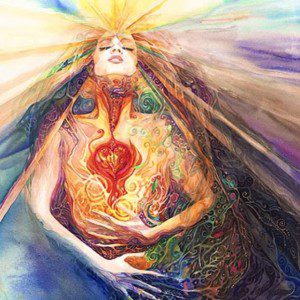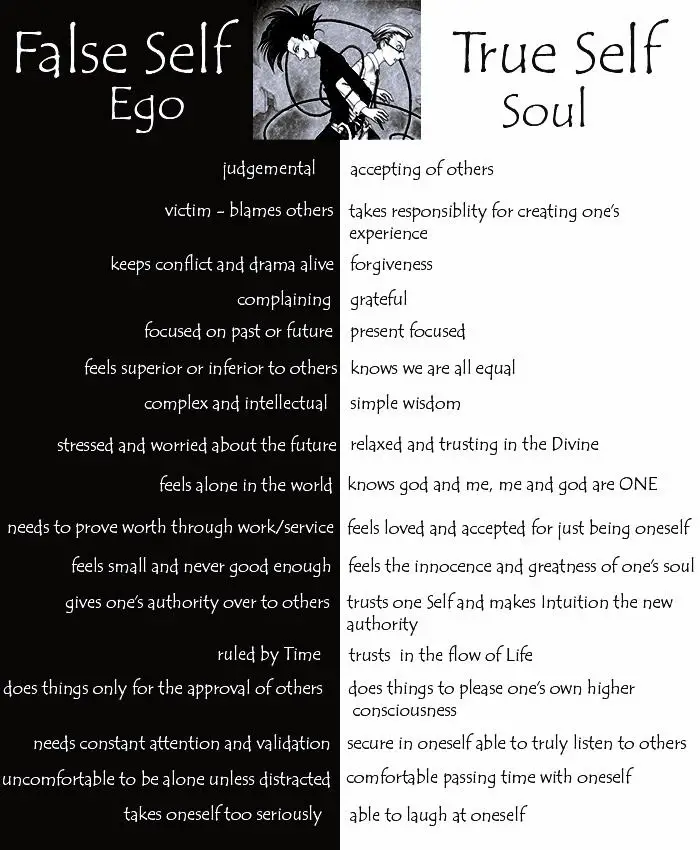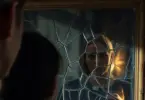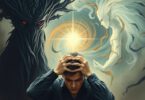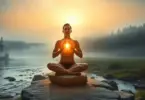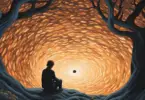9th February 2015
Guest Writer for Wake Up World
Many people are striving to be happy. All over the world many of us feel compelled to grow and find a personal and collective state of joy and peace. When we face this enormous so-called challenge of becoming happier, we realize that there is no other form of growth than self-development, and that this journey is all about self-discovery.
It is common to seek answers to the questions “why” is this or that happening to me? But certainly, this leads to a great frustration as we realize there is no real or satisfying answer. We then move to a much more relevant question: “how do I become that person I want to be”, and without hesitation this dilemma encounters the greatest question of all: “Who am I?”.
Getting to Know the Ego
[pro_ad_display_adzone id=”110028″]
One of the major stumbling blocks we find on the journey of self-discovery, is the Ego. When we come to Eastern perspectives, it is frequent to find the notion of letting go of the Ego.
How does this really work? Who am I beyond my Ego?
First of all we need a definition of Ego to give us a common ground for what we are talking about in this article. Although Psychology has made long-term attempts at defining Ego, nowadays there is a growing awareness that we must manage the Ego, along with other associated concepts, and moreover, that we must find ways of applying these ideas to our real life. In this article I will give grounded notions of the Ego and its adherent concepts so that we can learn to work with ourselves in our daily life.
Just as we need a vehicle to travel long distances, we need an Ego to function and navigate our way through this third dimension. Just as with our car, where we don ´t always know the various mechanical parts and their functions, we are aware that it functions and serves a purpose for our car to operate, so too can we apply this same concept to the Ego, a vehicle made up of parts that we require to operate effectively in this material reality.
Imagine yourself floating around with no purpose, and bumping into other objects in the world with no direction. It would be chaotic! So we need a guidance system, a sense of motion, and an inner pilot to help us navigate.
The Ego is a vehicle. But of what?
The real YOU!
Picture yourself sitting inside a computer, which for this example could be another type of vehicle. Imagine that the computer suddenly starts using YOU and begins to open programs and applications, and you have no control over it. It would be ridiculous right? It is just as ridiculous the way that the Ego – and its ally, the mind – controls our lives. So if the computer is the Ego and the mind is software, then who or what is controlling it?
YOU!
Who are YOU? Think for a moment on that.
There is an inner sense of YOU that moves beyond the vehicle(s), that has consciousness of the vehicle and gives purpose to its use. C.G. Jung would have defined that inner YOU as the Soul.
As the computer registers a history of how it was used and when, so does our Ego. We registered all of our impressions in the world as we grew up. Our first society is our family, directed by our parents, and this is the first mirror and given source of concepts that we get subjected to, taking them on as our own – it gives us the sense of who we are. And of course there is a whole realm of ourselves that we don ´t yet know (the personal unconscious).
But as our parents were also influenced and given their impressions by something else (the collective unconscious) our ego is a product of multiple, inherited patterns of conditioning (behaviors, morals, etc). Patterns of conditioning that serves to ‘model’ our external presentation, as Osho refers to it.
The Ego becomes a character built up by multiple characters, concepts and the roles we play in society, in fact everything we have learned externally as good or bad. So the Ego, the subject of consciousness, as Jung defines it, is the complex of things that we have identified with, and by which we function. In other words, what we know about ourselves, or what we have chosen to know about ourselves are those characters we play in all of our relationships.
But the Ego – the vehicle – is part of a whole, something bigger in which it is sustained. The Psyche! This bigger realm contains 2 dimensions: the conscious and the unconscious. In the field of the conscious the Ego resides. In the field of the unconscious the Self resides, that animus part of us that embodies and manifests the soul.
The consciousness would be like the property of our whole psychic realm of knowing itself.
The Traps of The Ego
So the Ego is made of characters and concepts learned (most of them imposed!) and just like movie actors, the Ego likes to play games between these roles. Emotion and commotion are the motors of this theatre, and although it can be fascinating it can also be very exhausting and destructive. The Ego was taught to manipulate and be manipulated, to attack and defend itself. So the vehicle that we are taught to use has these main functions.
As part of the show, the Ego is a creator and victim of this orchestrated illusion. It relates primarily to the external world, thus, likes to control the uncontrollable. The Ego knows that the realm of the unconscious is by nature, uncertain, and so as a vehicle, needs a structure to feel secure. It will do anything to keep holding the great illusion of a perfectly controlled and manipulated world outside, where everyone else is revolving around it and fulfilling its demands.
This is what we call the traps of the Ego
It will lie, push, demand, defend, attack, compete, protect, constrain, yell, and dramatize, as far as it can go, so as to keep up this ongoing game of sustaining the main illusion of control.
The greatest joke of all is that the Ego makes a fool of itself! As it is oriented towards the outside world, the Ego won ´t take responsibility for itself, tending to judge and blame the outside world for its results. It is very worthwhile to take not that we don ´t see things as they are, we see them as WE are. The great illusion being that happiness, or connecting to God, is something you search for on the outside, is merely a notion that comes from the Ego.
On a collective level, the sum of Egos builds up a conditioned and rigid society whose individuals are confined to determined ways of behaving, resulting in a world of black and white, good and bad, a consensus of “normality” and what is expected of each one. There is no room for spontaneity, authenticity and creativity, because this defies the old rigid ways of the Ego, and so we learn to compromise our inner truth from the very beginning. And every time the illusion is cracked open, it is hurtful for the Ego – but the Ego is NOT the true self!
The process by which the Ego arrives at a False Self instead of a Real Self is a matter of a whole new article; however, it is central to understand how this vehicle can be oriented to fulfill one way or another. The Ego, which is an essential quality of the human being, is prone to support either the negative sides of yourself or the positive ones.
On a metaphysical level, the ego vibrates mainly on FEAR (of the natural uncertainty of reality), so it serves a very specific purpose, that of protecting the human body, its functions, and the embodied soul. Although it may surprise you, this is a very essential aspect of the Ego for the human being; if it weren ´t for the ego, we would have no notion of the material world and our soul – and its floating nature – would make us just wonder around, not assimilating that a passing car or a raging lion could kill us. This is where the feeling of separation originally arises from, since we are born in a finite body, we adjust to the consciousness of differentiation from infinity.
Nevertheless, the ego is supposed to be what it essentially is: a vehicle for the soul in this third dimension. And, as my Kundalini Yoga Master used to say to me, “the rest is Maya (illusion) and games”.
Transforming the Ego
As we now know, the Ego is a necessary mechanism of the human reality, as it translates the experiences of the outside world to our inner sense of being – we cannot get rid of the Ego, and trying to eliminate the Ego in the sense of doing battle with it, can even create more duality and suffering. However, if we remember the principle of the Universe, ‘nothing is created, nothing is destroyed, everything is transformed’, then we can have a closer sense of the Ego work that is there to be done: Transformation.
As C.G. Jung and many others have explained that transformation can only happen when we first accept. Acceptance has the quality of inclusion and integration and resonates on the level of LOVE, which is the Soul ´s nature.
Accept what?
Everything that is beyond the boundaries of the Ego (including it), uncertainty and the unknown. The Ego can only be transcended, this means, accept it and go beyond.
Beyond where?
Not to the outside world but within. As we move towards the inner self (the manifested aspect of the Soul) we delve into the unconscious and the unknown. This is the place that in Transpersonal Psychology is called “The Shadow”: hidden unconscious aspects of oneself which the Ego has either repressed or never recognized. It is the part of us that holds the potential of becoming our True Self, it is where our authenticity, spontaneity and all the past wounds related to them are resting, constituting at the same time, our greatest fears.
The wise Miguel Ruiz said that what we mostly fear is to become our True Self, and to do that we need to transcend the Ego, go beyond its mechanisms and tune into acceptance. This is why we mostly experience the opposite of the Ego in this process: vulnerability, openness, innocence, flexibility, softness, neutrality. Recalling on C.G. Jung, “the psyche is transformed or developed by the relationship of the ego to the unconscious”.
That which you reject gives you the opportunity of going deeper within you. Working with the Shadow is like going inside a dark room. You move around it, explore the experience with your whole senses and intuition and reach for the power switch (that holds your potential), finally turning the light on. This light, which is our Consciousness, suddenly brings a sense of completeness again. The more lights your turn on within, the more consciousness you have of yourself, and the saying “we are light” makes even more sense. It is in this light that it is possible to embrace our own divinity because there is full acceptance and consciousness of who we truly are.
This is how self-discovery leads to wisdom; you have the experience of your Inner Self. Transcending the Ego, which implies then, to go within and not outside of yourself, because on the inside our Soul is connected to the Cosmic Consciousness, the Original Experience. “Who looks outside dreams; who looks inside awakes” (C.G. Jung).
To contribute to the evolution of humanity, we must start with ourselves. As we unfold our own personal subconscious, defying our Ego with divine courage, we dive into our own personal consciousness, and thus we contribute to the collective consciousness, and its enlightenment too.
As we move closer to the Soul, let us give the vehicle (Ego) a chance to be what it its meant to be: an expression of the Soul, serving and manifesting our Inner Self in the outside world.
Opportunities to Heal and Work with The Ego
- Get to know your Shadow and work with it.
- Unidentify from your regular beliefs. Remember beliefs are temporary and they will change just as your circumstances do.
- Get to know your Inner Self through the realm of the body; ask yourself frequently “What am I feeling right now?” and let the answer unfold itself by sensations instead of words at first. Take your time! This is not a fast exercise.
- Gain consciousness of your ‘roles’ and ‘characters’ – which are the most common ones you fall into and when do they ‘come out to play’?
- Practice consciousness: be a witness to yourself, use slow and deep breathing, and gain mindfulness about everything you do.
- Get to know yourself in these four dimensions, differentiating between them: thoughts, feelings, sensations, intuitions.
- Practice interesting games such as suspending of judgments for a whole hour, or expressing yourself without swearing to see what other language and form of expression comes out of you.
- Adopt an innocent attitude as if you were a child, and play the learning game for a whole day: Rediscover everything, give yourself the chance of not knowing (and be ok with it), give yourself the chance of not having the last word nor trying to prove someone wrong. At the end of the day ask yourself gently: What did I learn from myself today?
- If you made a mistake, laugh at yourself, laugh with yourself, then forgive yourself, just as an act of love.
- Explore what happens to you internally if something doesn ´t go your way. Explore your reactions. Write them down. Then read them out loud pretending you are a character from a movie. What do you feel?
- At the end of the day, be thankful for all the ‘bad things’ that happened. Explore what feelings and fears come to you. Let them exist. Allow yourself to truly thank bad things that happened. Practice this for a week and register what changes in you after this.
About the author:
 Carolina Israel Mosqueira: I am a Clinical Psychologist, Holistic Psychotherapist and Coach, Kundalini Yoga Teacher and Speaker. Lover of life, dreamer and optimistic advocate for social change. I work enhancing the human consciousness towards wellness, quality of life, integrative health and human virtues. I have been studying and working with integrative perspectives for almost a decade, bringing consciousness to psychotherapy and daily life. I have worked one-on-one, with groups and also with children, bringing all my background to Conscious Parenting Coaching too. For healing, I use Transpersonal Flower Essences, Tantric Numerology (Karam Kriya), Gestalt Psychotherapy, Self-Discovery Coaching and intuitive foresight, depending on each person ´s need. You can contact me at: caroisrael@gmail.com
Carolina Israel Mosqueira: I am a Clinical Psychologist, Holistic Psychotherapist and Coach, Kundalini Yoga Teacher and Speaker. Lover of life, dreamer and optimistic advocate for social change. I work enhancing the human consciousness towards wellness, quality of life, integrative health and human virtues. I have been studying and working with integrative perspectives for almost a decade, bringing consciousness to psychotherapy and daily life. I have worked one-on-one, with groups and also with children, bringing all my background to Conscious Parenting Coaching too. For healing, I use Transpersonal Flower Essences, Tantric Numerology (Karam Kriya), Gestalt Psychotherapy, Self-Discovery Coaching and intuitive foresight, depending on each person ´s need. You can contact me at: caroisrael@gmail.com
[pro_ad_display_adzone id=”110027″]

